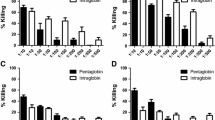Summary
The results of the chemiluminescence activity determined in whole blood samples very often were used to compare the unspecific defense mechanism of polymorphonuclear granulocytes (PMN) against causative organisms to preoperative capable risk parameters in surgery. Our investigations try to compare the results of a bacteria-induced chemiluminescence with those we received from a standardized agar killing plate-test. It could be shown that there is no correlation between the used two test systems. Therefore it is not possible to conclude from the chemiluminescence results especially made out of whole blood samples to the potency of the defense mechanism of PMN granulocytes.
Zusammenfassung
Der Chemiluminescenzmessung neutrophiler Granulocyten im Vollblut wird häufig eine Aussagekraft über das Abwehrverhalten der Granulocyten zugeordnet. In unserer Versuchsserie wurden die Ergebnisse der bakterieninduzierten Chemiluminescenzmessung isolierter neutrophiler Granulocyten mit einem Agar-Plattentest verglichen. Es konnte gezeigt werden, daß zwischen der Chemiluminescenzmessung und dem Bakterienkilling im Agar-Plattentest keine Korrelation besteht. Diese Ergebnisse machen deutlich, daß die Chemiluminescenzmessung alleine keine umfassende Aussage über das Abwehrverhalten der Granulocyten zuläßt und damit als Risikoparameter bei chirurgischen Patienten generell überbewertet wird.
Similar content being viewed by others
Literatur
Allen RC, Stjernhohn RL, Steele RH (1972) Evidence for the generation of an electronic excitation state(s) in human polymorphonuclear leucocytes and its participation in bactericidal activity. Biochem Biophys Res Commun 47:4, 679–684
Cheson BD, Christensen RL, Sperling R, Kohler BE, Babior BM (1976) The origin of chemiluminescence of phagocytizing granulocytes. J Clin Invest 58:789–796
Coons AH, Kaplan MH (1950) Localization of antigen in tissue cells, II. Improvements in a method for the detection of antigen by means of fluorescent antibody. J Exp Med 91:113
Dempster AP (1972) Covariance selection. Biometrics 28:157–175
Ferrante A, Thong YH (1978) A rapid one-step procedure for purification of mononuclear and polymorphonuclear leucocytes from human blood using a modification of the hypaqueficoll technique. J Immunol Methods 24:389–393
Ferrante A, Thong YH (1980) Optimal conditions for simultaneous purification of mononuclear and polymorphonuclear leucocytes from human blood by the hypaque-ficoll method. J Immunol Methods 36:109–117
Fischer H, Staudinger HJ (1981) Chemilumineszenz, ein Indikator für Zellaktivierung? Klin Wochenschr 59:199
Harbeck RJ, Hoffman AA, Redecker S, Biundo T, Krnick J (1982) The isolation and functional acitivity of polymorphonuclear leucocytes and lymphocytes separated from whole blood on a single percoll density gradient. Clin Immunol Immunopathol 23:682–690
Heberer M, Dürig M, Ernst M, Fabricius S, Jäger G, Harder F (1982) Die Chemiluminescenz von Granulozyten. Helv Chir Acta 49:109–112
Heberer M, Ernst M, Dürig M, Allgöwer M, Fischer H (1982) Measurement of chemiluminescence in freshly drawn human blood. II. Clinical application of zymosan-induced chemiluminescence. Klin Wochenschr 60:1443–1448
Heesemann J, Keller C, Morawa R, Schmidt N, Siemens HJ, Laufs R (1983) Plasmids of human strains ofyersinia enterocolitica: Molecular relatedness and possible importance for pathogenesis. J Infect Dis 147:1, 107–115
Heesemann J, Laufs R (1985) A double immunofluorescence microscopic technique for accurate differentiating between extracellulary and intracellulary located bacteria in cell culture. J Clin Microbiol 22:168
Heesemann J, Dziwisch L, Kremer B (1987) The microscopic doubleimmunofluorescence technique, a method for quantitative differentiating between extra- and intracellulary located bacteria in isolated polymorphonuclear granulocytes. (In Vorbereitung)
Hjorth R, Jonsson AK, Vretblad P (1981) A rapid method for purification of human granulocytes using percoll®. A comparism with dextran sedimentation. J Immunol Methods 42:95–101
Jules Mattes M, Tanimoto M, Pollack MS, Maurer DH (1983) Preparing monolayers of nonadherent mammalian cells. J Immunol Methods 61:145–150
Kihlström E (1977) Infection of hela cells with salmonella typhimurium 395 ms and mr 10 bacteria. Infect Immun 17:290–295
Kremer B, Früh C, Homann NP, Reuter K, Bornholdt D (1983) Immunreaktivität, ein präoperativ faßbarer Parameter? Langenbecks Arch Chir 361:269–275
Marre R, Stübner G (1985) Persönliche Mitteilungen zum KeimPseudomonas aeruginosa 31 90 14 S.
Rehpenning W (1983) Multivariante Datenverarbeitung. Springer, Berlin Heidelberg New York
Robinson P, Wakefield D, Breit SN, Easter JF, Penny R (1984) Chemiluminescence response to pathogenic organisms: normal human polymorphonuclear leukocytes. Infect Immun 43:744–752
Sachs L (1969) Statistische Auswertungsmethoden. Springer, Berlin Heidelberg New York
Stevens P, Young LS (1977) Quantitative granulocyte chemiluminescence in the rapid detection of impaired opsoization ofEscherichia coli. Infect Immun 16:796–804
van Furth R, van Zwet TL, Leigh PCJ (1978) In vitro determination of phagocytosis and intracellular killing by polymorphonuclear and mononuclear phagocytes. In: Handbook of experimental immunology. vol 2. 3rd edn, Cell Immunol, pp 32.1–32.19
Vesikari TC, Sandquist C, Mäki M (1983) Adherence and toxicity ofyersinia enterocolitica 0:3 and 0:9 containing virulence-associated plasmids for various cultured cells. Acta Pathol Microbiol Immunol Scand [B] 91:121–127
Weinstein RJ, Young LS (1976) Neutrophil function in gram-negative rod bacteriamia: The interaction between phagocytec cells, infecting organisms, and humoral factors. J Clin Invest 58:190–199
Welch WD (1980) Correlation between measurements of the luminol dependent chemiluminescence response and bacterial susceptibility to phagocytosis. Infect Immun 3/2:370–374
Author information
Authors and Affiliations
Rights and permissions
About this article
Cite this article
Dziwisch, L., Kremer, B., Heesemann, J. et al. Chemiluminescenzmessung phagocytierender Granulocyten - Gleichzeitig ein Parameter für ihre Killing-Funktion?. Langenbecks Arch Chiv 370, 173–183 (1987). https://doi.org/10.1007/BF01259537
Received:
Issue Date:
DOI: https://doi.org/10.1007/BF01259537



